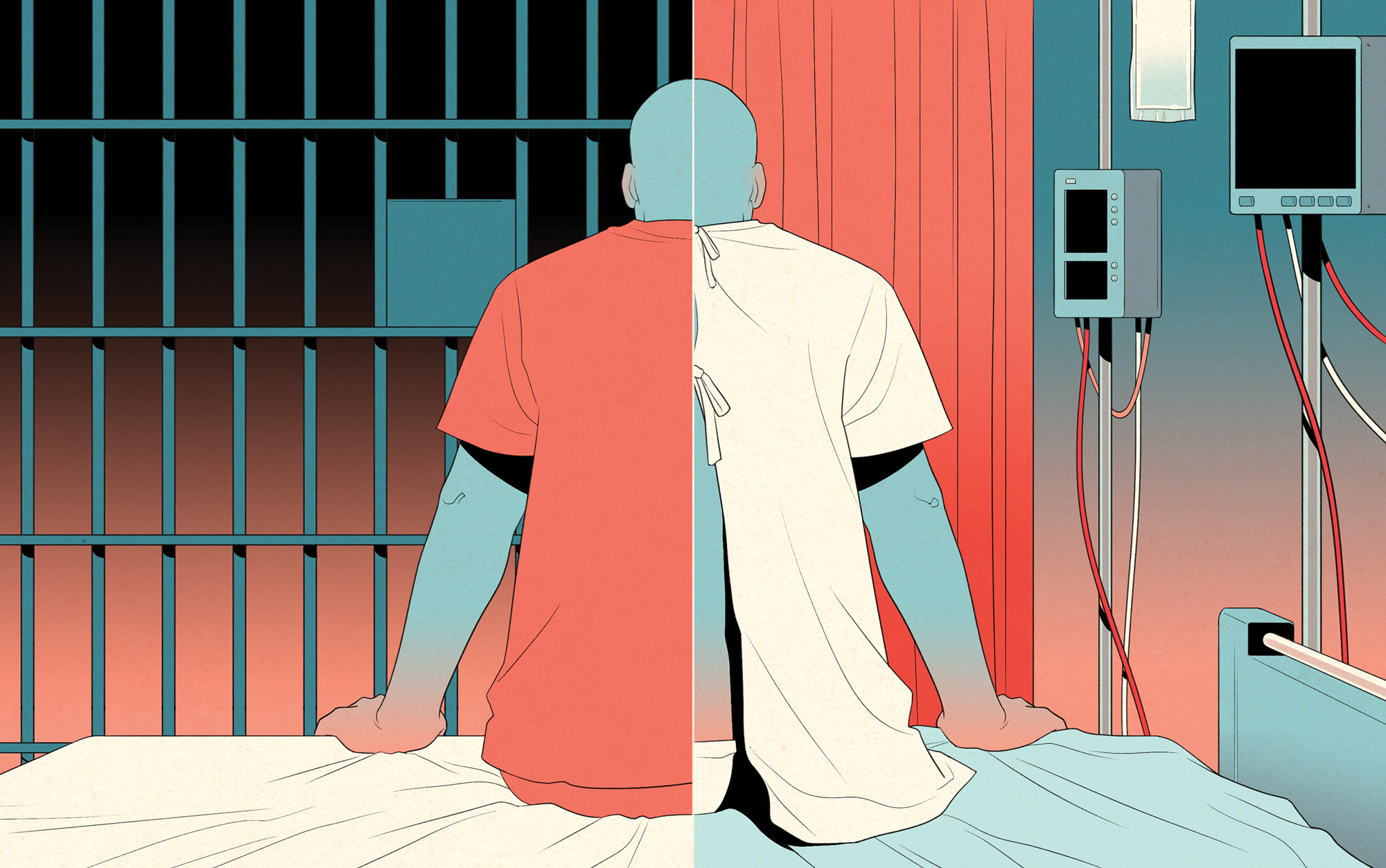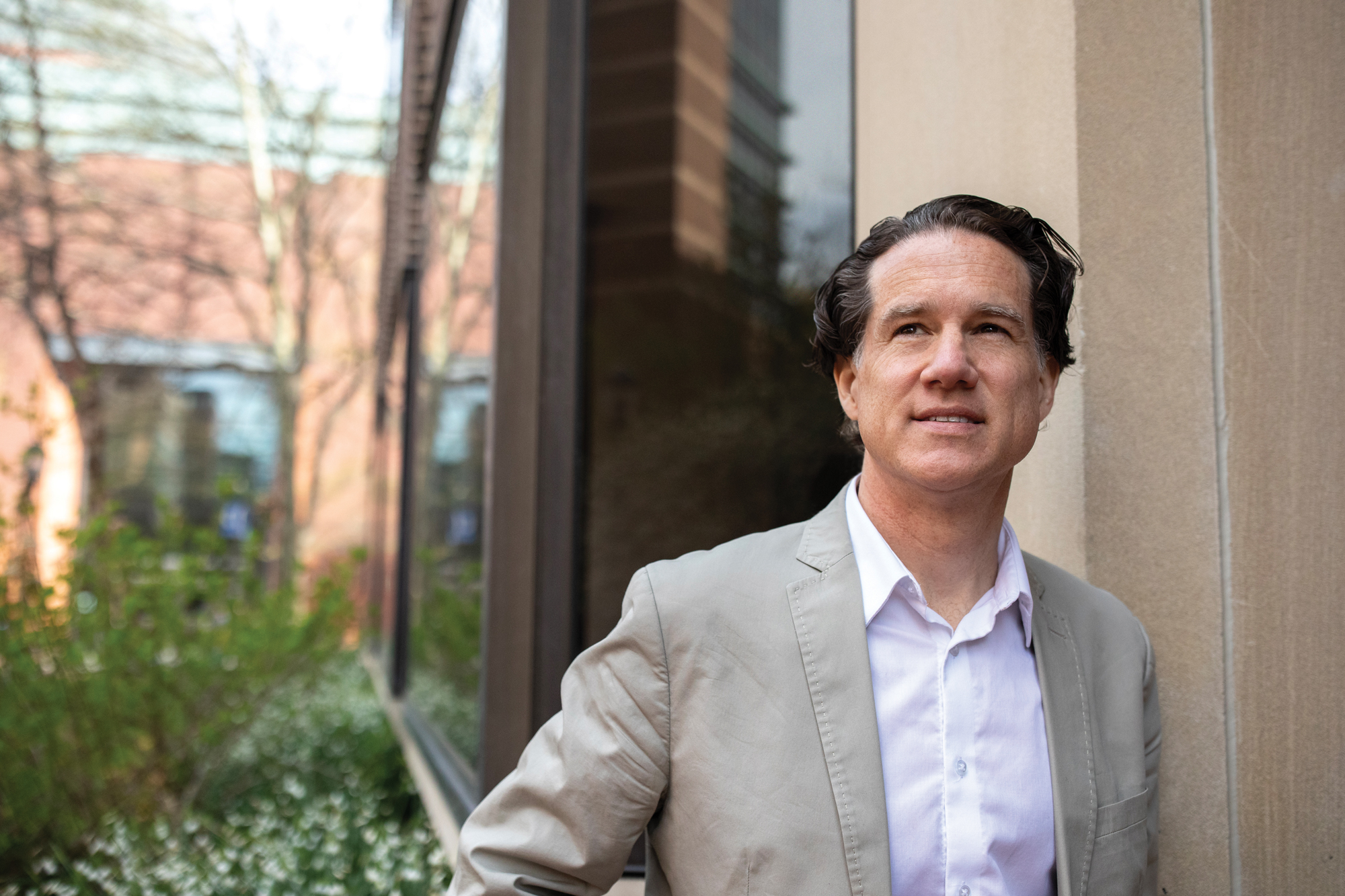At the Intersection of Incarceration and Health
Medical sociologist Jason Schnittker explores the paradox of healthcare and prison.

When Jason Schnittker published a study about the long-term effects of incarceration on health in 2007, he had not veered far from his expertise. Schnittker, a sociology professor, had devoted most of his research to mental health and the inequalities that stem from socioeconomic status, race, and gender.
“So, the incarceration piece was at the intersection of all those,” Schnittker says. “It hit me at that time that I was working on it.”
His first paper on this topic, co-authored with a Penn undergraduate student, discovered a paradox that has since driven Schnittker’s work. He could not know that 15 years after that paper, this journey would bring him to Copenhagen to dissect trends among Danish prisoners.
Medical sociologists had mostly ignored the health effects of incarceration. Using data that followed incarcerated people over time, Schnittker found that prisoners reported their health improved while serving their sentences but, once they were released, it deteriorated relative to comparable people. Although prisons are designed for punishment, they are required by law to provide healthcare.
“We thought that was a pretty provocative result,” Schnittker says. “It left open a lot to be explained.”
He partnered with two sociology professors from the University of Wisconsin and the University of Minnesota to write Prisons and Health in the Age of Mass Incarceration. The book was published this past September. Oxford University Press labeled it “the first comprehensive and empirical book focused on the connection between incarceration and health.” The policies that drove mass incarceration were shifting, and the three sociologists concluded that rehabilitation in a correctional facility should not be restrictive or reactive. It should improve and restore.
This, they said, could reduce the cost to society once someone is released. Research for the book began in 2009, and between that time and the book’s 2022 release, policymakers across the country had reassessed the place of prisons in American society. Schnittker and his coauthors captured the changing trends.
“It evolved in an unusual way,” Schnittker says. “We initially thought of it as an unusual stress. A trauma. These lasting impacts. Then, there is a sea change in the policy environment and the discussion around incarceration. We just followed the lead on it.”
That brought Schnittker to Denmark the summer before the book was published. He worked with researchers at the ROCKWOOL Foundation, analyzing data that captured the mental-health effects upon prisoners’ release. The criminal justice system is very different there, but Schnittker saw similarities in the trends.
Fifteen years after wondering why medical sociology had neglected health in prisons, here he was uncovering another layer to his research. “It was an intellectually demanding project,” says Schnittker. “It pulled me out of my comfort zone in many ways. That’s been rewarding.”
Exploring the Paradox
When it comes to criminal justice in the United States, Schnittker says, there are certain constraints on the imagination. Underlying everything is a set of assumptions about the purpose of prisons: incapacitate and punish—or rehabilitate. His research reinforced a deep connection between incarceration and health.
“Yet for all the evidence tying the two institutions together,” he writes, “policymakers and the public fail to grapple with a central fact: that prisons are squarely in the business of providing healthcare.”
By the time Schnittker and his coauthors (Michael Massoglia and Christopher Uggen) had published their book, there were larger conversations happening about how this country imprisons people. Some were motivated by calls for racial justice, others driven by the rising costs associated with the incarceration of more people than any other nation in the world. The pandemic forced a review of everything, and one immediate byproduct was a reduction in the prison population.
“It’s an interesting time in the sense there is a real reform push,” Schnittker says. “There are people thinking about this seriously. It cuts across party lines. People recognize it’s just not working. It’s a time when you need not be cynical. People are actually listening and trying to figure these things out. There have been states that have decarcerated.”
The prison may have a smaller footprint on American society moving forward, and Massoglia, a sociology professor at the University of Wisconsin, says it’s a chance to consider a better post-release protocol for inmates. “Where could we do better?” Massoglia says. “There are not a lot of places we could do better, with more bang for your buck and less public opposition than basic medical care.” The risk factors for going to prison, Schnittker and his coauthors found, are quite similar to those for bad health.
Parolees are often asked about their living situation and job status as they reenter society.
“And it wouldn’t be that hard,” Massoglia says, “to work in something like, ‘Did you see your doctor? Are you in communicative therapy?’”
The authors found inmates’ physical health often improved while in prison, but mental-health issues were exacerbated. There is a certain stigma and stress associated with a criminal record, with a distrust of institutions layered on top. More therapy while imprisoned and a more direct transition to health providers once released could reduce the risk of reoffending. A recent study, Schnittker says, investigated states that had expanded Medicaid and found declining rates of rearrest.
A 1976 Supreme Court ruling guaranteed healthcare to inmates, but in the decades since, it’s been hard for prisons to disentangle their criminal justice mandate with this mandate of providing care.
“What we’re advocating for is expanding it a little more,” says Schnittker. “Thinking about the intersection of health and criminal justice and reoffending and putting it broader than ‘avoiding cruel and unusual punishment.’ Getting people to a position where they can reintegrate and they’re not going to come back to that prison. They can find that job. They can be a supportive spouse or father or mother.”
Policymakers and the public fail to grapple with a central fact: that prisons are squarely in the business of providing healthcare.
Massoglia credits Schnittker with shaping the larger ideas that tie together these complex systems. “Our work has helped us see that prison has impacts on all of us,” Massoglia says, “even those who don’t go to prison.” It affects community health. And, for Schnittker, this project tapped into issues he had grappled with since graduate school. Fitting into society. The institutions that determine our health. The intersection of mental, physical, and behavioral health.
It made for compelling research at a time when the discourse surrounding incarceration has shifted.
“Even if you don’t have special sympathies for folks who are incarcerated, people do realize that poor health undermines a lot,” Schnittker says. “They think about prisons primarily as a form of punishment and custody. But they’re also thinking that this is making things worse for them when they are released. They’ve paid their debt to society. Now you need to get back on your feet and you’re in poor health. That would be hard for me. It would be hard for them. People are thinking about health in a more expansive way.”
And Schnittker forecasted it.
“He sees things just a little bit before other people do,” says Massoglia, “and certainly the field has been moved forward because of that.”
A Research Thread Without End
Two years ago, Shubha Vasisht, C’23, took Schnittker’s Medical Sociology class. “That really started my own passion for the field,” says Vasisht, a computational biology major. She declared a minor in medical sociology. Then she became a teaching assistant for Schnittker, and when she was applying for medical school, she asked him to write her a recommendation letter.
Schnittker, a professor at Penn since 2001, agreed. But he wanted to interview her first.
Changing the Equation for the Incarcerated
As an undergraduate, Mona Merling heard all types of inspirational stories from her Bard College professors teaching classes at prisons. Some incarcerated students were mathematics majors working toward a senior thesis—just like her—and this stuck with Merling as her career progressed in higher education.
When she joined the Penn faculty as an assistant professor of mathematics five years ago and searched for area universities that offered a program similar to Bard’s, she encountered some dead ends before discovering the Prison Teaching Initiative (PTI), founded in 2005 by some Princeton astrophysicists. PTI provides college credit courses—taught by graduate students, postdocs, faculty, and staff—to incarcerated students in New Jersey. “They immediately embraced me,” Merling says.
That initial inquiry has grown to include about 15 Penn graduate students who have served as volunteer instructors for classes at South Woods State Prison in Bridgeton, New Jersey. Merling has also designed a bachelor’s-level course incarcerated students can take. This work is another way Penn scholars from various disciplines have engaged in solving the problems associated with the effects of incarceration.
Merling’s collaboration with PTI is supported, in part, by a Klein Family Social Justice grant, a Penn Arts & Sciences program that funds academic activities that use the arts and sciences to contribute to positive social change. Her class is among the first STEM offerings to incarcerated students in New Jersey.
“They’re a lot more mature than any students we’ve ever had, and a lot more engaged,” says Merling. “They have to wait on a waitlist, sometimes for years, to get into these classes. Some of them have not done any advanced math. So, I think they really appreciate this opportunity.”
At first, Merling thought she’d teach a straightforward math class—non-Euclidean geometry, or something like that. Then, Merling paired with Hannah Schwartz, a postdoctoral researcher at Princeton, to come up with something better aligned with criminal justice— the only B.A. degree offered in New Jersey prisons.
“Hannah knew about this book about famous court cases that misused math,” Merling says. “So, it’s a math class. But it also has a criminal justice aspect to it.” She adds that the students are “excited to see these applications and connections that are, of course, very relevant to them.”
The class has 11 students and meets once a week for two-and-a-half hours. Merling’s teaching team includes Ellen Urheim, a lecturer in the Penn math department, and two Penn graduate students, Rebecca Fishman and Deependra Singh. Merling’s bachelor’s-level class is offered through Rutgers University.
She hopes to expand Penn’s involvement in the program. “It’s great that we have math graduate students and math faculty involved because we’re really excited about math,” Merling says. “And we love teaching math. I think it’s easy to get other people excited.”
“He really tried to delve into why I’m interested in certain things,” Vasisht says. “He tried to understand it himself to get a better perspective of me as a student. His ability to get to know his students well—to be able to better meet them where they are—is something that really stands out to me about him as a professor and as a mentor.”
In Schnittker’s teaching, Vasisht says, students recognize how adept he is at making complex ideas accessible. Schnittker’s research is typically a solo effort. He authored a book in 2017 on the classification and treatment of psychiatric disorders and another book in 2021 on anxiety.
But, as his own studies about health and prisons intensified, he realized he needed different perspectives.
He cold-called Uggen—who became one of his coauthors—with no idea where the initial inquiry could lead. “Here was a topic where it just taps into so many different things that I felt as an academic, you had to be a little bit modest,” Schnittker says. He envisioned the book being the capstone, but he’s since pulled on new threads related to health and prisons. There was the trip to Denmark. Then Massoglia suggested a project tying together incarceration and the risk of Alzheimer’s disease.
“I was discovering these relationships,” says Schnittker. “I was looking at all this data. It felt surprising. It felt rewarding. It felt like I was uncovering something that I couldn’t have foreseen.”
A colleague, aware of Schnittker’s recent work, approached him with a new challenge. She was conducting research on those convicted of genocide in Rwanda and, as those criminals neared the end of their prison terms, they were willing to be interviewed. Schnittker could assist in studying their mental health before and after release.
You’re making an investment in folks who are particularly disadvantaged and who run the risk of falling through the cracks of society. This is a case where it’s an investment that reverberates more than you might think.
What that project and the others he’s already done made Schnittker realize is that the intersection of health and prisons has no limits. He is hopeful his book can influence policy decisions as more and more states consider reforms. The time is appropriate for a meaningful conversation.
“Most of the data suggest that in the long term, a spell of incarceration is bad for your health,” Schnittker says. “It doesn’t have to be bad for your health. There are changes we can make to prisons themselves, but also the environment outside of prisons that can eliminate that relationship. That’s good for everybody. Obviously, it’s good for the folks who are incarcerated. But it’s good for communities. It’s good for families.
“You’re making an investment in folks who are particularly disadvantaged and who run the risk of falling through the cracks of society,” Schnittker adds. “This is a case where it’s an investment that reverberates more than you might think.”
For one medical sociologist, it’s a topic he’s pursuing deeper than he ever expected.






